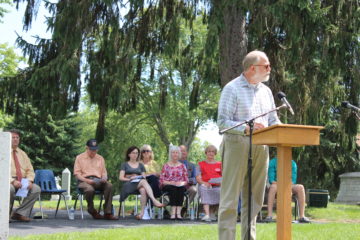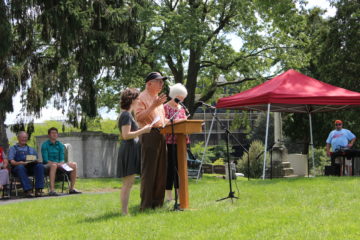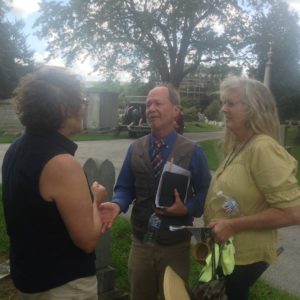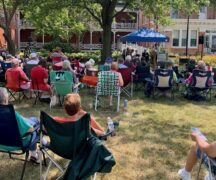By DAVID DUPONT
BG Independent News
Voices from Wood County’s past gathered and spoke Sunday at the 13th Annual Wood County Living History Day.
Though no longer walking among us, these figures, said master of ceremonies Michael Penrod still have an impact on how we live.
This collection of personages brought together by the county Historical Society had in common the theme of collections. They collected or the work they created was collected.
Dominick Labino, a glass innovator in industry and art, created distinctly colored glass pieces that are in museums around the world. “That’s quite legacy,” said Keith Guion, the actor who portrayed him.
Dorothy Uber Bryan’s paintings created while undergoing treatment for ovarian cancer are collected at the University of Toledo Health Science campus.
Ella Dishong’s collection was the assembled goods of the small rural business proprietor that over time became collectible.
Floy and Earl Shaffer found themselves collecting as a diversion from the grief of losing two sons, one as a child, and one in middle age. And Floy Shaffer’s own pottery was collected by regional buyers, including those who purchased her work in the early days of the Ann Arbor Street Art Fair.
Lloyd Weddell’s skill as a woodworker meant his figurines and fiddles were treasured by many in the area.
Jerry Hagerty’s interest in collecting Native American artifacts found in recently tilled farm land was one of the reasons he was asked to be the first caretaker of the Wood County Historical Center and Museum.
Together these seven people’s stories, each presented by an actor and through a script penned usually by someone who knew them well, offered a slice of the county’s collective memory.
Dominick Labino

Keith Guion as Dominic Labino
Labino’s story, told by Guion and written by his protégé Baker O’Brien, begins with his early admiration for the blacksmith in the town he grew up in. He admired the man’s ability to repair anything. Labino entered the glass industry and invented a number of patented products. He helped develop the glass fibers used on the bottom of the space shuttle.
His fame came when he was asked by Otto Wittmann, the director of the Toledo Museum of Art, to lend his expertise to the fledgling effort to explore the use of glass in art. He built the first furnace. He went on to retire from business early so he could pursue art. He built a studio at his Grand Rapids home and experimented endlessly. “I tried just about everything.”
The result was distinctive bold colored art works that are treasured by collectors.
Dorothy Uber Bryan
Bryan was presented through a short play acted by her daughter Katherine Hollingsworth, granddaughter Meredith Hollingsworth, and son David Bryan, in a script penned by Bryan and Meredith Hollingsworth.
Bryan was a busy wife and mother, raising her children and supporting her husband Ashel Bryan’s banking career, even preparing the food for the MidAm Bank Christmas party.

From left, Meredith Hollingsworth, David Bryan and Katherine Hollingsworth perform a one-act play about Dorothy Uber Bryan.
But once her youngest daughter was in high school, she decided to study painting at Bowling Green State University. There, working with students younger than two of her three own children, she was dubbed “Grandma Go-Go.”
At BGSU, she and several other older women studying art founded the Medici Circle, a group that continues to support the BGSU School of Art.
When she had cancer, “the way I got though was to go to my art studio and my feelings would come out on the pages, so I would feel better.”
Later looking over the series of paintings she “realized there was a progression.”
Those Chemo Paintings because the subject of a public television documentary produced by WGTE-TV.
The program still shows up at odd hours on various public television stations. Bryan recalled waking up in the early morning hours, and unable to go back to sleep, turned on the TV only to see an image of his much younger self in mutton chops. “That’s not something you want to see at 3 a.m.”
The short play ended with a mystery. Bryan said when the paintings were brought together for donation to UT, they realized that the final one in the series was a print, not the original painting. He vainly called to his mother as she slipped back into eternity: “Where’s the original?”
Ella Dishong
Ella, portrayed by Nancy Buchanan who also wrote the script, was married at 16 to storekeeper Uriah Dishong.
Some years earlier her father had gotten into an argument with a neighbor about a property line. He told to go home and get his shotgun. She did and her father killed the neighbor.
He served time for the killing and when he got out decided to relocate his family to Minnesota. Ella didn’t want to go, so she stayed behind and married Dishong in 1884 and ended up having nine children.
They moved to Hoytville and started a store, through the years launched a series of other businesses. They delivered goods to people in rural areas in the days before the Black Swamp’s deep drainage ditches had been dug. “You name it we sold it.”
When she died in 1948 she left instructions that her granddaughter could take what she wanted for an antique store she was opening in Anna.
Lloyd Weddell
Lloyd Weddell, portrayed by his son-in-law Bob Willman with monologue by his daughter Janette, carved an artful career from a hard-scrabble life. He was born in 1916 in a log cabin to immigrants from Scotland. His family lost their homestead during the Great Depression, and he had to leave school in eighth grade to join his brothers working on the farm the family rented.
He didn’t really take to farm work. “I was always a dreamer” who was always thinking of things to make. He got into his father’s tools and started whittling. He got in trouble when his father discovered he had literally “whittled down” a pile of wood shingles needed for repairs. Still his father encouraged him as long as he stayed away from the shingles.
He became a carpenter and did a great deal of work at Schedel Gardens in Elmore and late in life at events sponsored by restaurant magnet Bob Evans, whom he’d known growing up in Scotch Ridge.
Weddell also brought in money playing fiddle from age 12, for local dances. He once played 14 dances in as many days. He also played some banjo and bass fiddle.
And he made his own instruments, as well as instruments for other. The figurines he carved late in life became collector’s items.
Jerry Hagerty
Jerry Hagerty, portrayed by local actor Zack Robb with a monologue by Guion, had developed over the course of his life the skills needed to be the first curator of the historical museum. From his early years on his family’s 600-acre spread in Virginia, he knew about old farm implements.
From his own years as a butcher and as a meat and pop delivery man, he knew the byways and people of Wood County. And since he was 13, when he discovered a perfectly formed arrowhead, he was an inveterate collector of Native American artifacts, able to determine the age and tribe that made the object.
As he traveled his routes as a delivery man, he would spy promising, sandy-soiled locations, knowing how long after a field was worked over by the disc to look for these ancient treasures.
Hagerty spent five years living with his family at the former Wood County Infirmary as the museum took shape. After weathering the Blizzard of ’78, he decided that he and his family had had enough, so he retired again and moved back into town.
Floy and Earl Shaffer
The program concluded with a double portrait of husband and wife, Floy and Earl Shaffer, presented by Mary Dennis and Bob Midden and written by family friend Wynn Perry.

From left, Wynn Perry, who wrote the script honoring Earl and Floy Shaffer,chats with Bob Midden and Mary Dennis who portrayed the couple.
A twin, Floy, was “a tomboy to the core.” Not interested in lady-like instruments such as the piano or violin, she played the tuba. She liked to run about, not sit still in company. “I never really fit the mold of a young lady.”
Earl Shaffer met Floy when he went to teach in Upper Sandusky, where her mother was the head teacher.
Shaffer as a teen suffered from severe acne, which at the time was treated with radiation, a new therapy. He developed skin cancer. “I don’t know how many grafts I’ve had on my face.”
Still Floy was smitten by the former football player and the school’s coach – his team earned a state championship.
They married in 1943. Their first-born was a son, Tom, who died from a misdiagnosed case of appendicitis at 5.
Needing to change after that tragedy they built their own home using refurbished shipping crates.
The couple later had a son and a daughter.
Among those Shaffer taught was the future first man on the moon, Neil Armstrong. Armstrong’s family moved continually during his childhood, including spending time in Upper Sandusky. “He was such a strong student I always remembered him.”
The couple were drawn to socialist politics, with its advocacy for civil rights and organized labor. Much later Floy would attend the March on Washington and heard Martin Luther King Jr. deliver his “I Have a Dream” speech.
Earl took a job at BGSU in 1957.
By then Floy had started taken ceramic classes. “I’m a potter,” she would tell people who called her a ceramicist. She won Best of Show in the 1949 Toledo Area Artist Exhibition and later was accepted into a national traveling exhibit.
Her politics bled into her pots with such works as “Black Balled” to honor blacklisted leftist writers and “Peace Pot” to protest the Vietnam War.
Tragedy struck again when their son, Steve, a law officer stopped to help a drunken driver and was struck and killed along with the other man by another drunken driver.
Earl retired and the couple started frequenting yard sales. He was drawn to model trains. He’d loved trains since he was a child in Indiana. He came to focus on O-gauge like those he had as a child, and his father repaired.
His set took a place of honor at Christmas under the tree at the Hayes Center in Fremont. “I loved see them in the museum. I loved seeing everyone enjoying them.”
After Floy died in 1987, Shaffer began to travel through the Elderhostel program. The first trip he made was to the Southwest. She had always wanted to travel there to study Native American pottery, and while there her husband got to meet one of her idols Maria Martinez.
Shaffer’s cancer came back “with a vengeance” and he died in 2008. His last words were: “Good morning.”





